How to use Microsoft Teams to improve collaboration
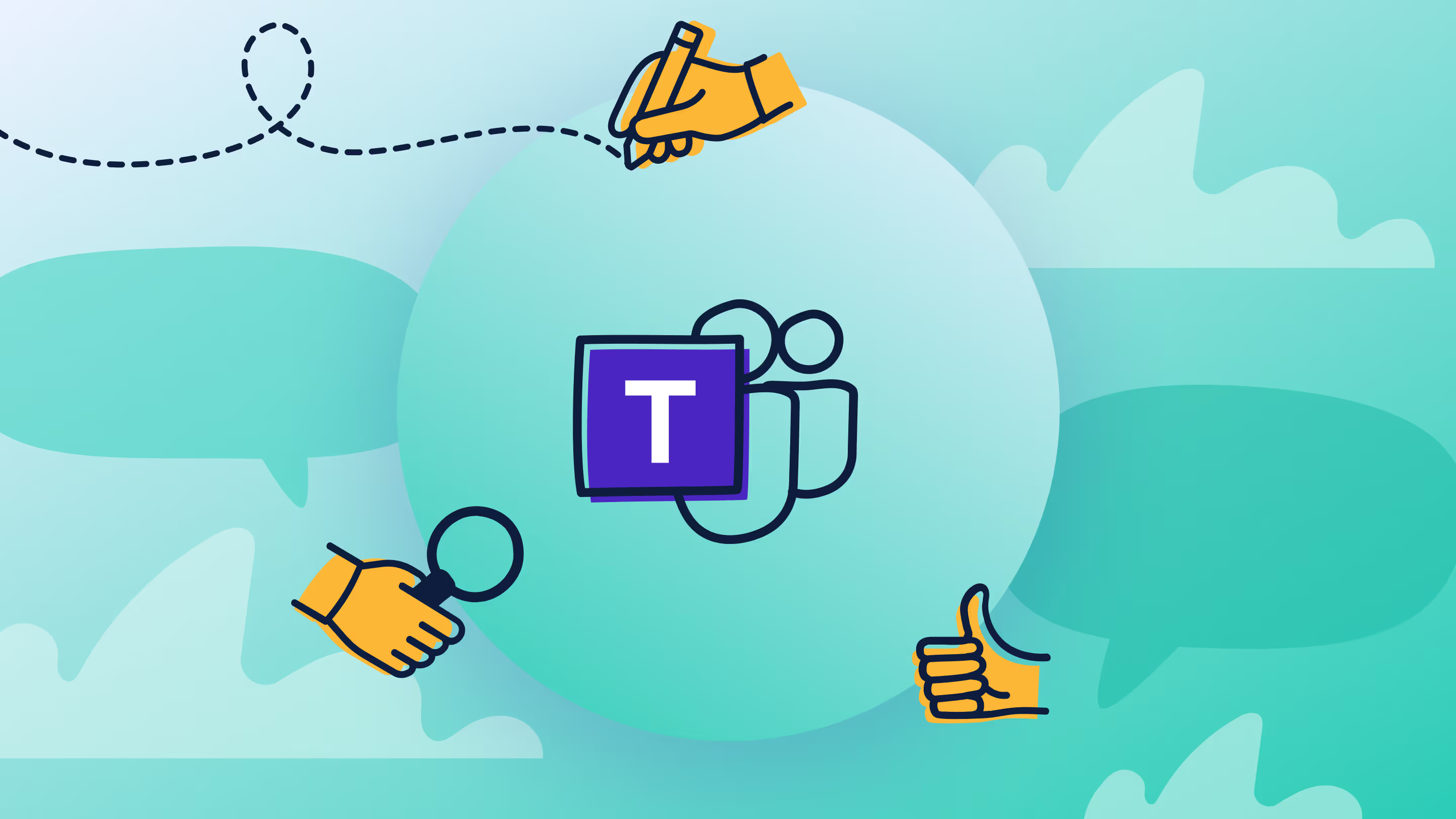
Table of contents
Microsoft 365 empowers teamwork and collaboration through a variety of tools and services. In this second installment of the Microsoft 365 collaboration tools series, dive into Microsoft Teams, including how to collaborate in Microsoft Teams and key features that make up the backbone of collaboration in the modern workplace.
Microsoft Teams is a communication and workplace collaboration platform that combines persistent chat capabilities, video conferencing, files storage, and integration with many other Microsoft 365 apps.
But with all these features, how exactly do you collaborate in Microsoft Teams? Let's look at how these features facilitate team collaboration using the well-known hypothetical company, Contoso Electronics, as our example.
Let's delve into what Microsoft Teams is and how it enables team collaboration.
Why collaboration matters in Microsoft Teams
Microsoft Teams has become the central workspace for collaboration in today’s hybrid world. It brings chat, meetings, and file sharing together so people can collaborate without friction. By keeping communication and content in one place, Teams helps distributed teams stay aligned, productive, and connected—no matter where they work.
Main collaboration features in Teams
You work for Contoso Electronics and are part of the launch team for the company’s flagship product, the X1050. You and your team members need a collaboration space in which to share and work on content. This is where Microsoft Teams leaps into action. As a day-to-day hub for teamwork, Teams has a variety of features that can benefit the X1050 team, such as:
- Instant messaging and audio/video chat that facilitates communication and file sharing
- Live meetings and on-demand recordings
- Integrations with Microsoft 365 apps such as Planner as well as third-party services
- Mobile Teams app for on-the-go teamwork
With all these features, it's no question why the Microsoft modern workplace is the go-to solution when you want to promote effective collaboration within your organization, especially in remote environments.
File sharing, channels, and chat
You open Teams at the start of your workday and browse to your favorite channel:
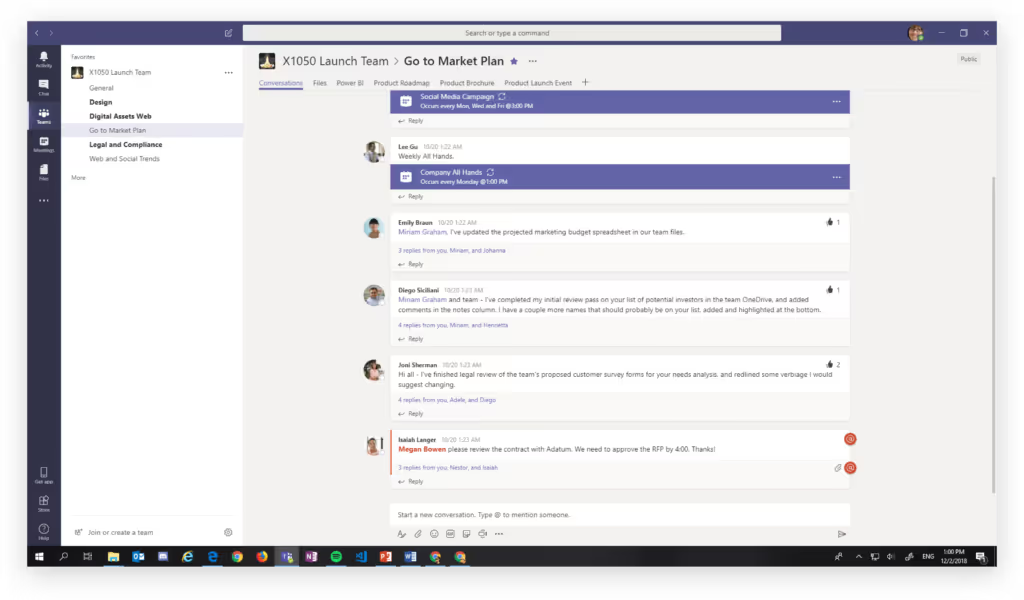
Use channels for focused conversations and collaboration surrounding a given topic. In this scenario, we're concerned with the go-to-market plan for the XT1050. Emily, your manager, put you in charge of delivering the XT1050 go-to-market presentation. You’ve already created the presentation with the help of your colleague Joni in OneDrive. Now it's ready to be shared with the rest of the team.
How to share a file in a channel in Teams
You share a file by clicking on the plus icon:
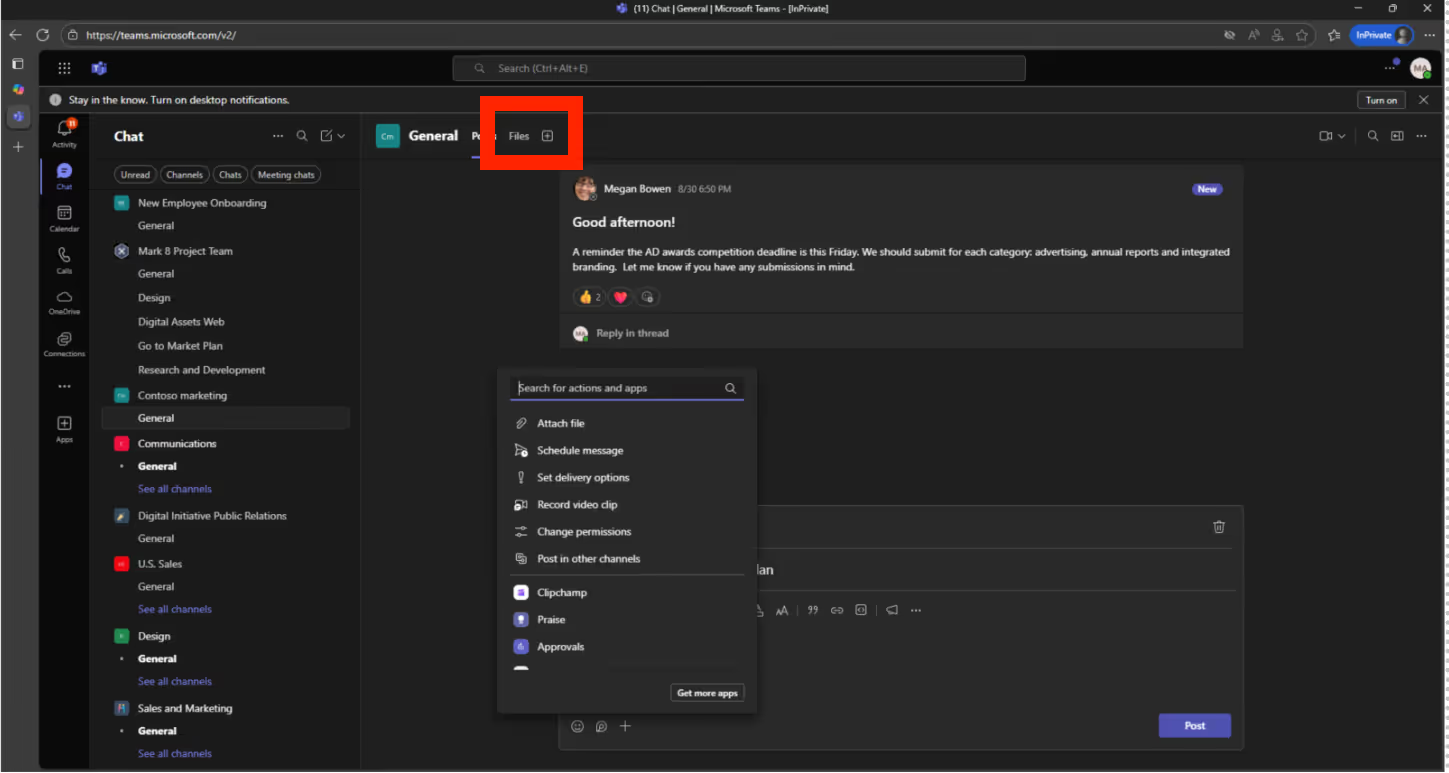
Select Attach file and a few options appear:
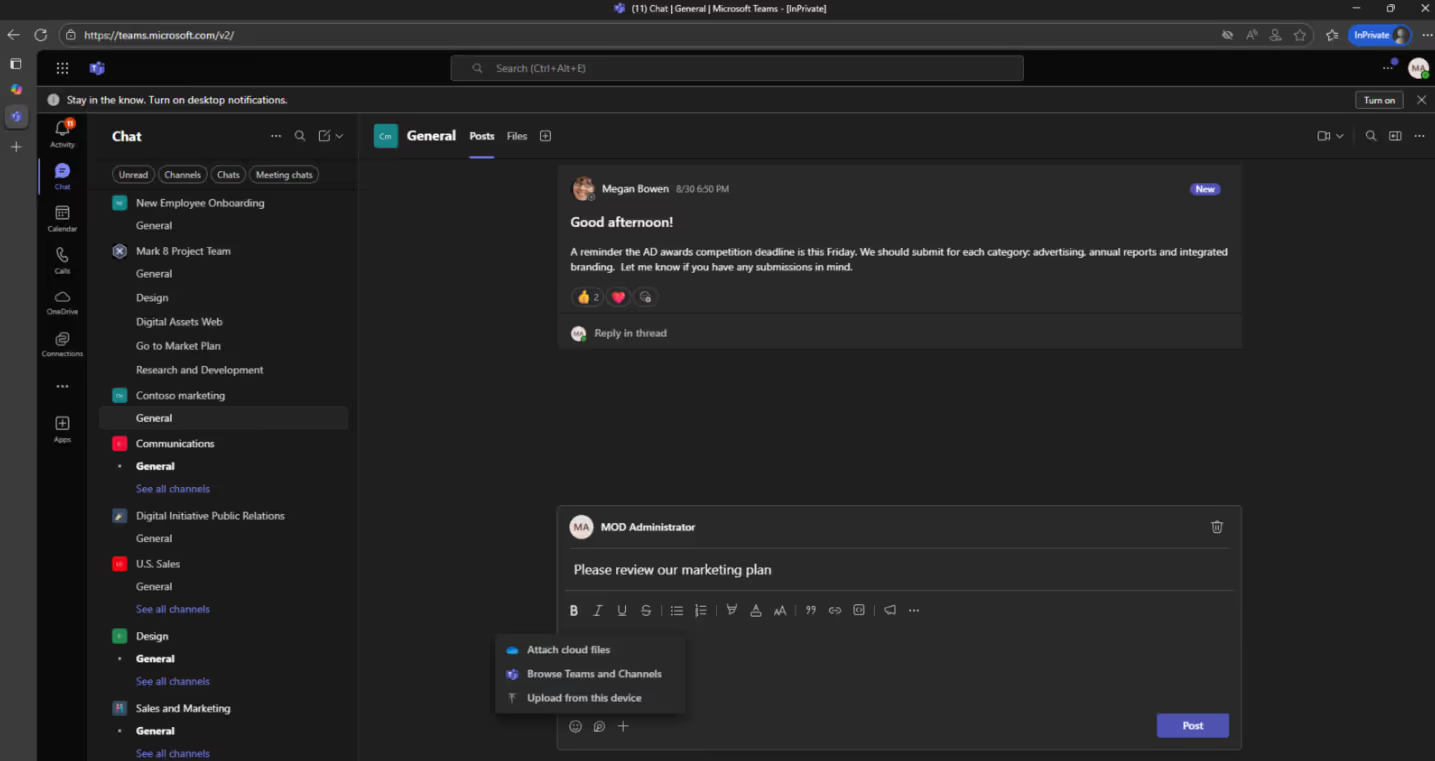
You can share a file from your OneDrive:

...teams and channels:

Or you upload a file from your device:

The file is stored in the files tab of the channel:

Your team members have access and you can start collaborating.
Use the @channel function to send a notification will be sent to all the team members who are following the channel. You can also use the @team function to send a notification to everyone on the team. Pick your mention wisely!
That’s the power of Teams in action. No emails—just a simple chat with all the modern communication features you expect:
- Likes
- @ mentions
- Emoji
- Gifs
- Stickers
The chat window contains an advanced editor with a lot of formatting options:

Your team members can open the presentation in Teams, in Office Online, or through the desktop Office client; co-authoring is available within all these options.
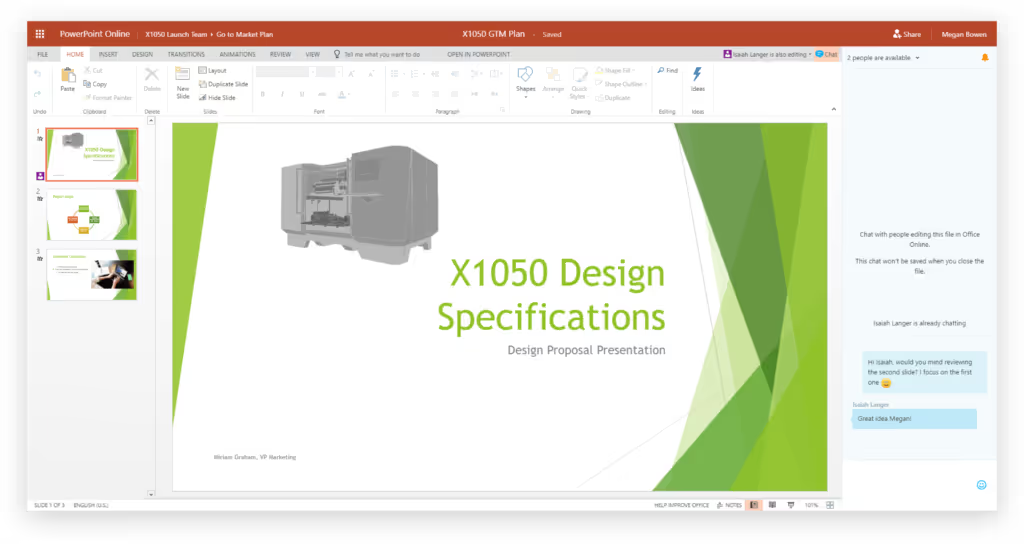
Check out our related article The ShareGate Guide to Microsoft Teams: Teams, channels, tabs & integrations
How to set up a meeting in Microsoft Teams
Your team members have reviewed the presentation and you’re now ready to present the final version. Through the integration with Exchange Online, you can quickly set up a meeting and invite your colleagues:
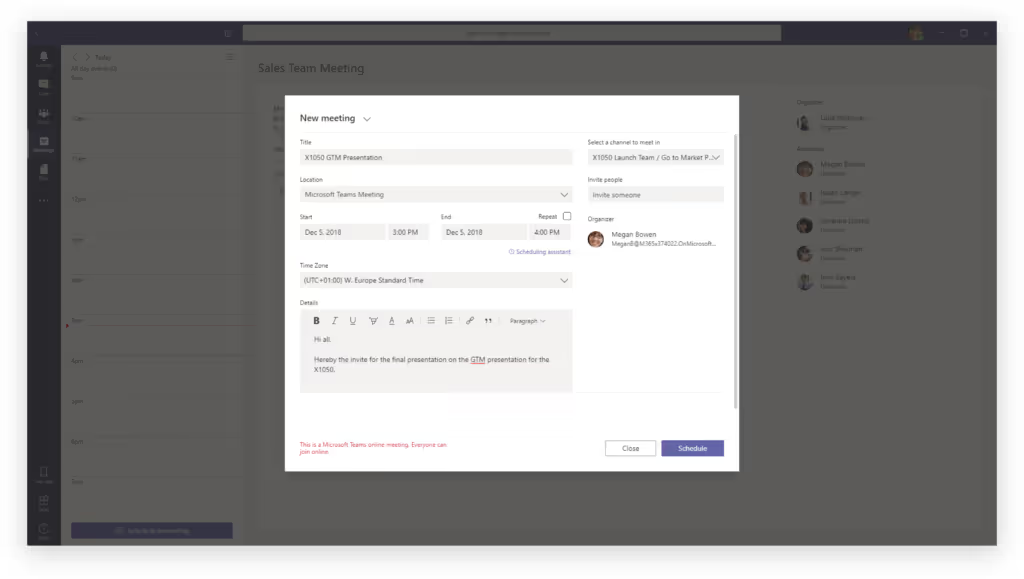
The Select a channel to meet in option allows you to pick a channel related to the meeting. Once the meeting is scheduled, it becomes accessible within the channel:
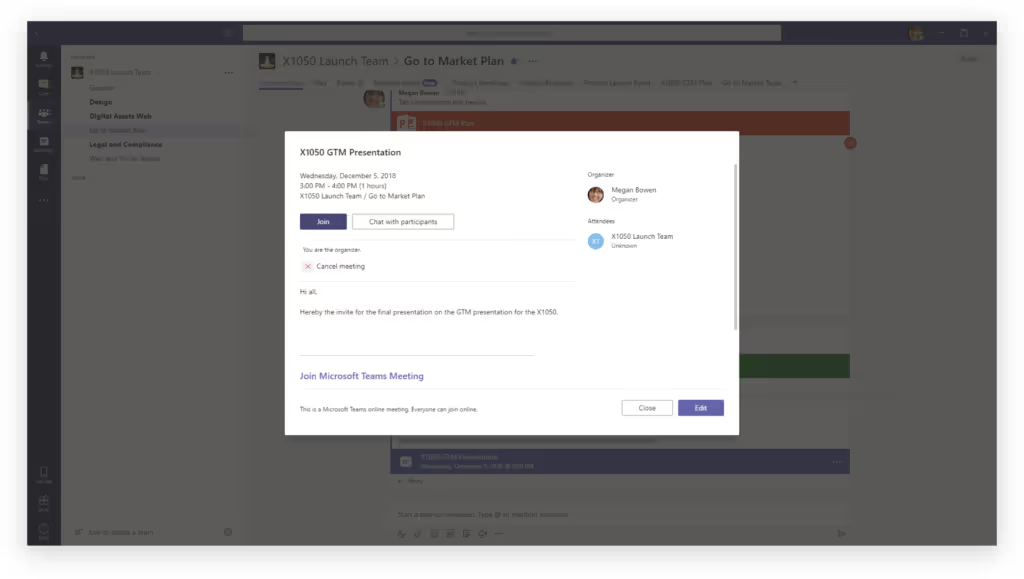
The meeting will automatically be added to your calendar because you’re the organizer, but other attendees will have to do this manually via the clickable option in the event view. Easy! Since the meeting was created in Teams, that’s where it’ll be held:

Not ready to show off your home office quite yet? Teams lets you blur or disguise the background of your video feed.
One of your colleagues can't make it to the meeting? With Teams, you can record the meeting for other team members to watch later. Such recordings are saved to OneDrive and SharePoint.
Concerned that a video from a private team will hit the whole company? No worries, the sharing permissions carry over from Teams.
Tools and apps to supercharge teamwork in Teams
Planner: This lightweight task management tool is a separate service within Microsoft 365, but it’s tightly integrated with Teams. You create a new tab within your channel and connect with Planner:
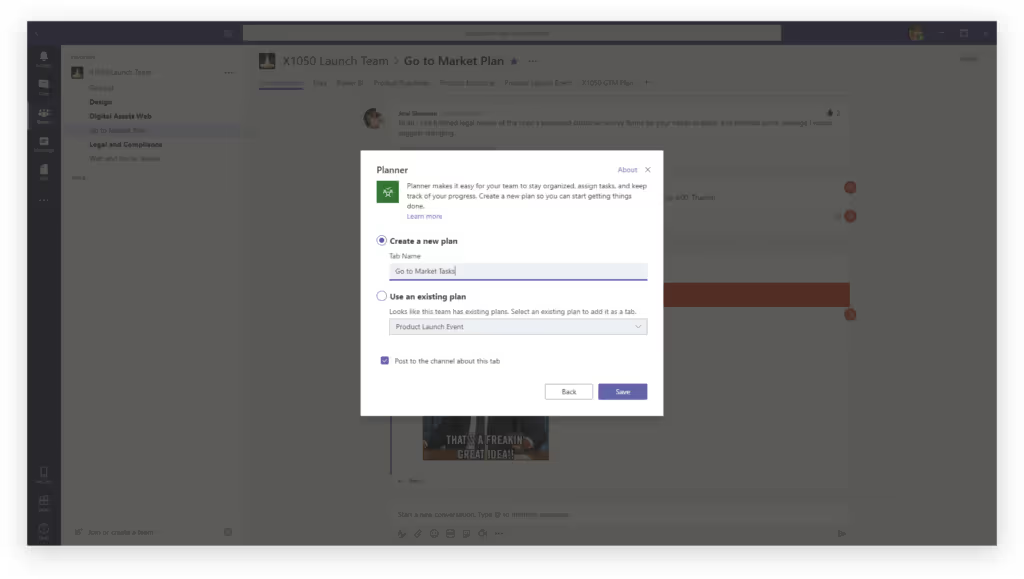
You quickly assign a series of tasks to yourself and team members:
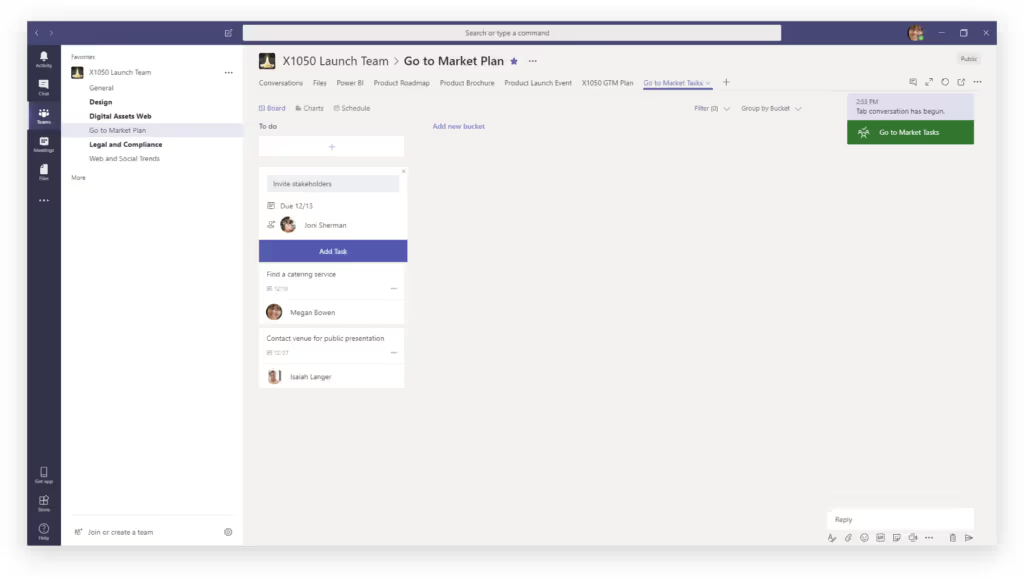
Planner allows you to attach files, photos, and links to a task:

The assigned team member now knows which content—in this case, the presentation—to use for their task.
Teams also integrated with many third-party applications. Here are a few examples of Teams third-party app integrations to facilitate collaboration:
- Manage Salesforce records from Teams channels and chat conversations with the Salesforce Teams integration
- Handle support tickets inside Teams with Zendesk Support integration
- Execute marketing tasks and better project management via Asana for Teams
Proven best practices for everyday teamwork in Teams
Collaboration in Microsoft Teams works best when there’s a balance between flexibility and structure. It’s not just about chatting or hopping on a call—it’s about making teamwork easier, faster, and less frustrating for everyone. That includes working with people inside and outside your organization.
Let’s take a look at some Teams collaboration best practices:
Collaborating with external users
You and your team have finalized the presentation, but now you need to collaborate with an external marketing company, Easterfield, for the consumer launch of the X1050.
First, you’ll need to send an invitation to the external consultant, who’ll get access to the whole Team space. Then, the private channel owner can add any member, including guests like this external consultant, to the private channel.
The external consultant, who already uses Teams, sees the connection with Contoso like this:
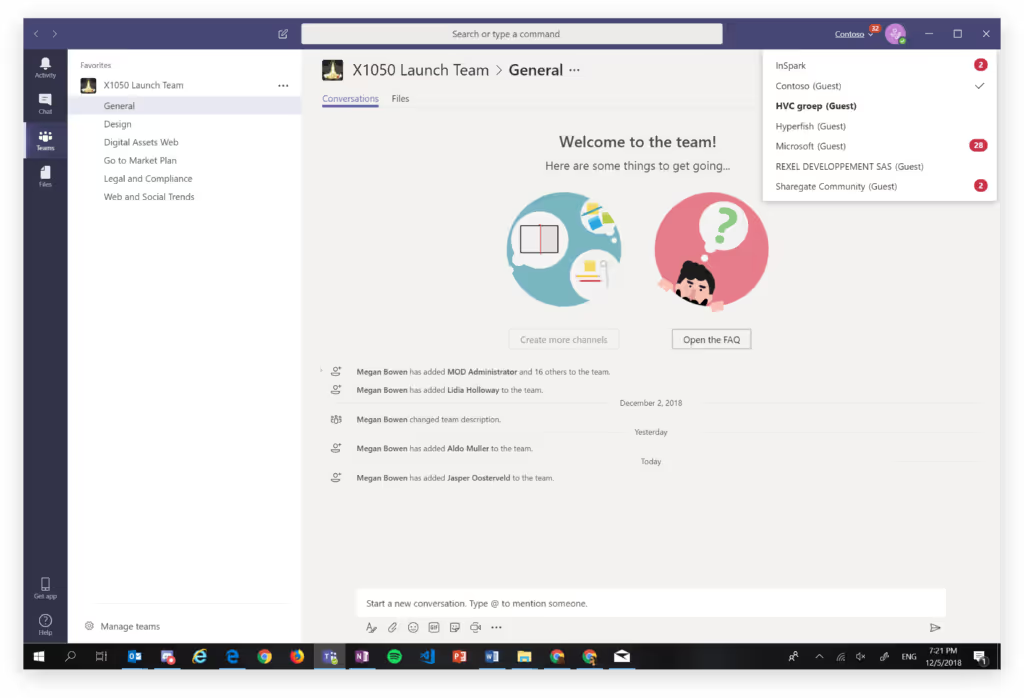
From my own experience, I know how difficult it can be to stay up-to-date while working in multiple external teams. I recommend asking your collaborators to @mention you on anything important so that you receive a notification.
The external consultant has a default set of options available. Microsoft has done an excellent job of documenting these features.
The correct settings have to be activated to collaborate with guests. Contact your Microsoft 365 administrators if you cannot invite guests. Administrators play an important role in governing external sharing in Teams and should always be included in your strategy.
Keep channels structured and naming consistent
A clear naming convention for channels avoids confusion. When everyone knows where conversations belong, it’s easier to find information and stay focused.
Use @ mentions and pinned posts to reduce noise
Not every message needs everyone’s attention. Encourage @ mentions for urgent updates and pin important posts so they don’t get buried.
Share and co-author documents in Teams instead of email
Skip the endless email attachments. Upload files to Teams so teammates can co-author in real time and always work from the latest version.
Use meeting recordings and transcripts to retain knowledge
Recording meetings and enabling transcripts helps teams catch up quickly and prevents knowledge from walking out the door.
Standardize how files and folders are shared across teams
Agree on a consistent way to structure and share files. This keeps collaboration smooth and prevents the dreaded “where’s that document?” hunt.
Quick wins to boost collaboration securely
The nature of Teams makes governance a bit tricky. Teams is connected with Microsoft 365 groups. Creating a team also creates:
- A SharePoint Online team site and document library to store team files
- An Exchange Online shared mailbox and calendar
- A OneNote notebook
- A PowerBI workspace
- A Stream video portal
A governance strategy is crucial to managing the impact on your modern workplace. Make sure yours covers the following essentials (I've included links to relevant content in Microsoft's documentation for each area of focus):
- Creation process
- Naming policy
- Expiration policy
- Soft delete and restore
- Policies and information protection
- Guest access
- Reporting
The Files section in Teams lets you connect with additional cloud-based file storage services (e.g. Dropbox). I recommend turning off this integration; otherwise, you won’t have any visibility over the content that moves in and out of your Microsoft 365 environment. In the previous article on OneDrive, I briefly discussed data classification, mobile device management, and mobile application management; the same advice applies to Microsoft Teams.
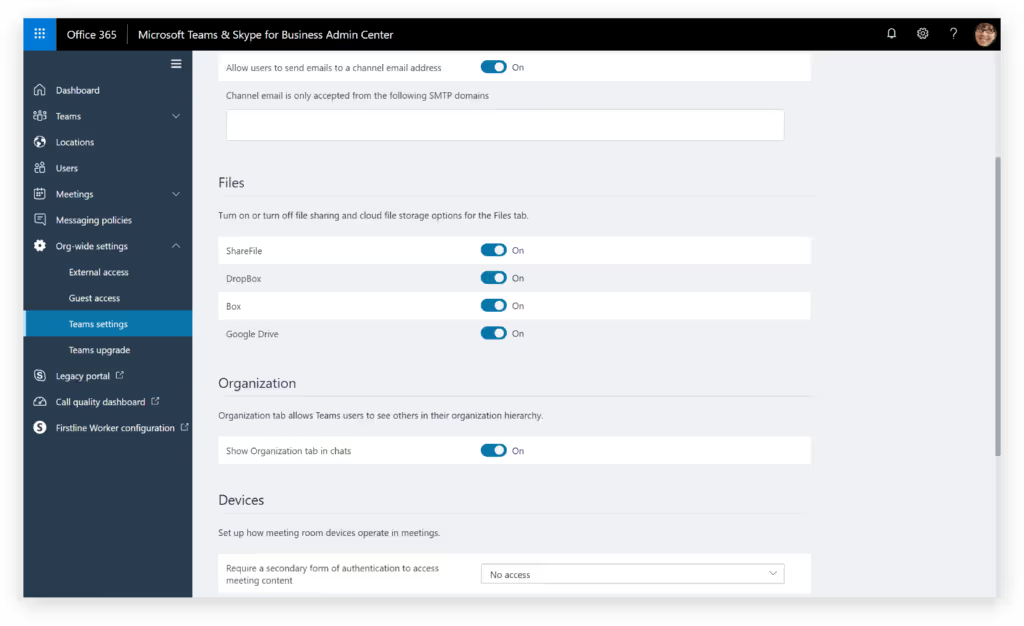
Why governance and control are critical in Teams
Teams is aimed at business users. Its user-friendly interface and integration with other Microsoft 365 services (like integrating Microsoft Teams with SharePoint sites) can result in a high level of adoption among first-time users.
But when Teams grows without governance, it can create as many problems as it solves.
For IT, governance isn’t about slowing people down—it’s about protecting data, reducing chaos, and making collaboration sustainable. For end users, it means fewer headaches, less clutter, and more confidence that they’re working in the right place.
Here’s why it matters:
- Avoiding Teams sprawl: Without structure, new Teams and channels pop up everywhere. Before you know it, there are duplicates, abandoned spaces, and too many places to look for information. Governance helps keep things organized and easy to navigate.
- Preventing data leaks: Teams makes it easy to share files and chat but it’s just as easy to overshare by mistake. Governance ensures the right people have access, guest users are managed, and sensitive data doesn’t slip out the door.
- Ensuring compliance: Whether it’s industry regulations or internal policies, compliance is non-negotiable. Governance puts the guardrails in place so organizations stay audit-ready, while end users can collaborate freely without worrying about breaking rules.
Adoption is also crucial. You can’t simply demo Teams, hand it over to a group of business users, and wave good luck from a distance. Instead, you need to explain how Teams fits into their existing collaboration process.
Don't forget: technology is awesome, but apps and services need to have a clear business value to succeed.
My advice for better Teams adoption:
- Speak with a group of business users who want to collaborate.
- Gather their requirements and compare them with the features in Teams.
- Use hands-on demonstrations to show the value Teams can offer.
- When the organization decides to move forward, provide training sessions to cement the adoption process.
Microsoft has a wealth of content on this topic online. I recommend starting here:
Balancing rapid collaboration with governance in Teams
Teams is built for speed. People want to create spaces, share files, and get to work fast. IT, on the other hand, needs to keep data secure and stay compliant.
You can’t pick one over the other—you need both. Collaboration keeps the business moving, while governance keeps it safe. And with the right tools, governance doesn’t slow things down. It simply puts guardrails in place so teamwork stays fast and secure.
Microsoft Teams and OneDrive, a match made in collaboration heaven
Teams is an intuitive, easy-to-use tool that’s ideal for content collaboration within a department or a project team. It's one of the reasons I fell in love with Teams from the moment of its release.
The integration with OneDrive lets business users start working on their files within a private space. Then, once it's ready to be collaborated on, you can move the file to Teams in a couple of clicks. This is the kind of content collaboration that the modern world is looking for.
As you can tell, Microsoft Teams is more than just a chat tool. Teams allows you to easily chat and meet, connect across apps, share documents, and co-author content in real-time. The service integrates with other Microsoft apps in the Microsoft 365 environment like Outlook, Word, and SharePoint to stimulate productivity across your teams.
In the third and final part of the series, we focus on SharePoint and its role as a collaboration tool in Microsoft 365.
.jpg)


.svg)
.avif)
%20(1).avif)





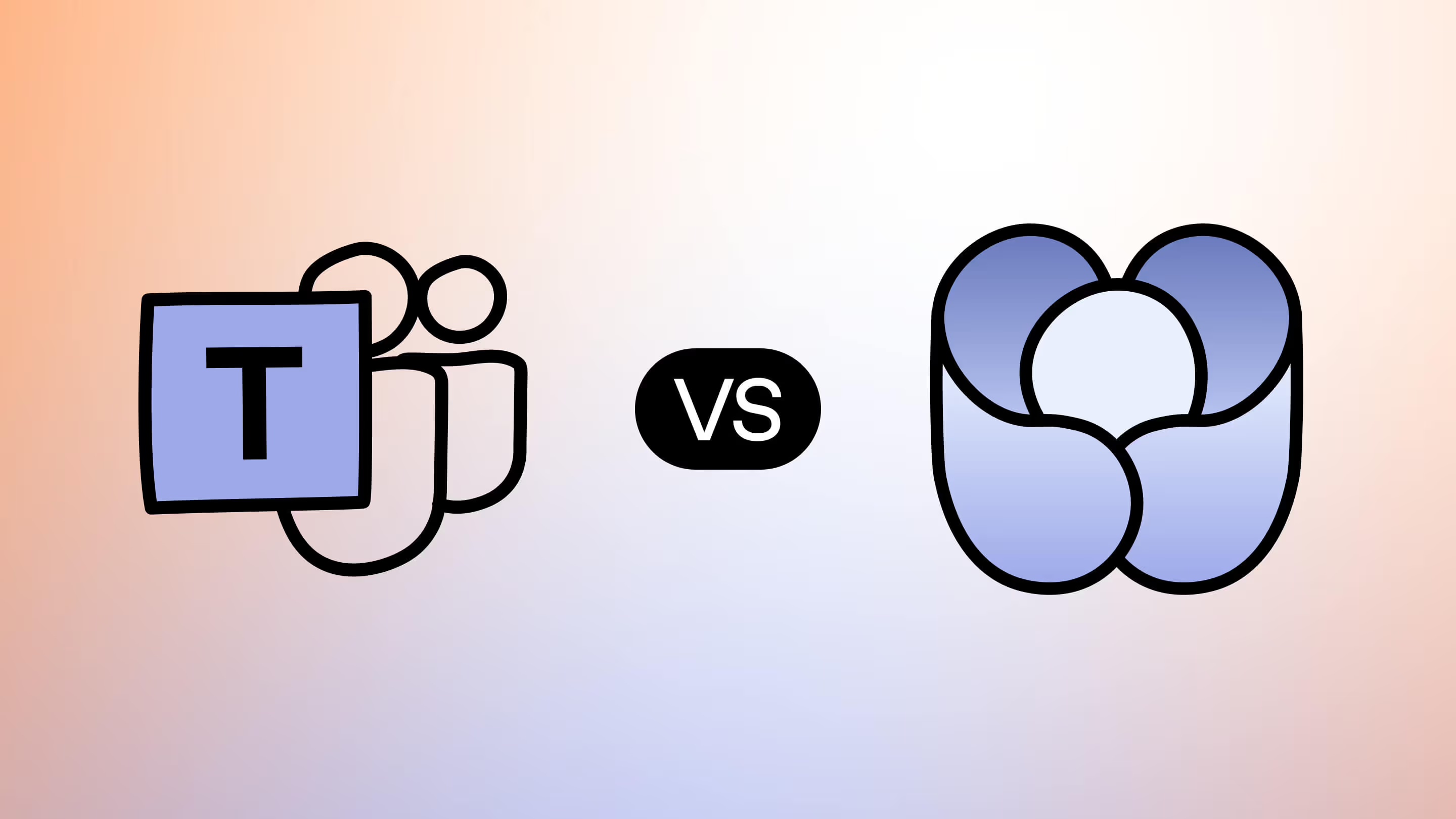

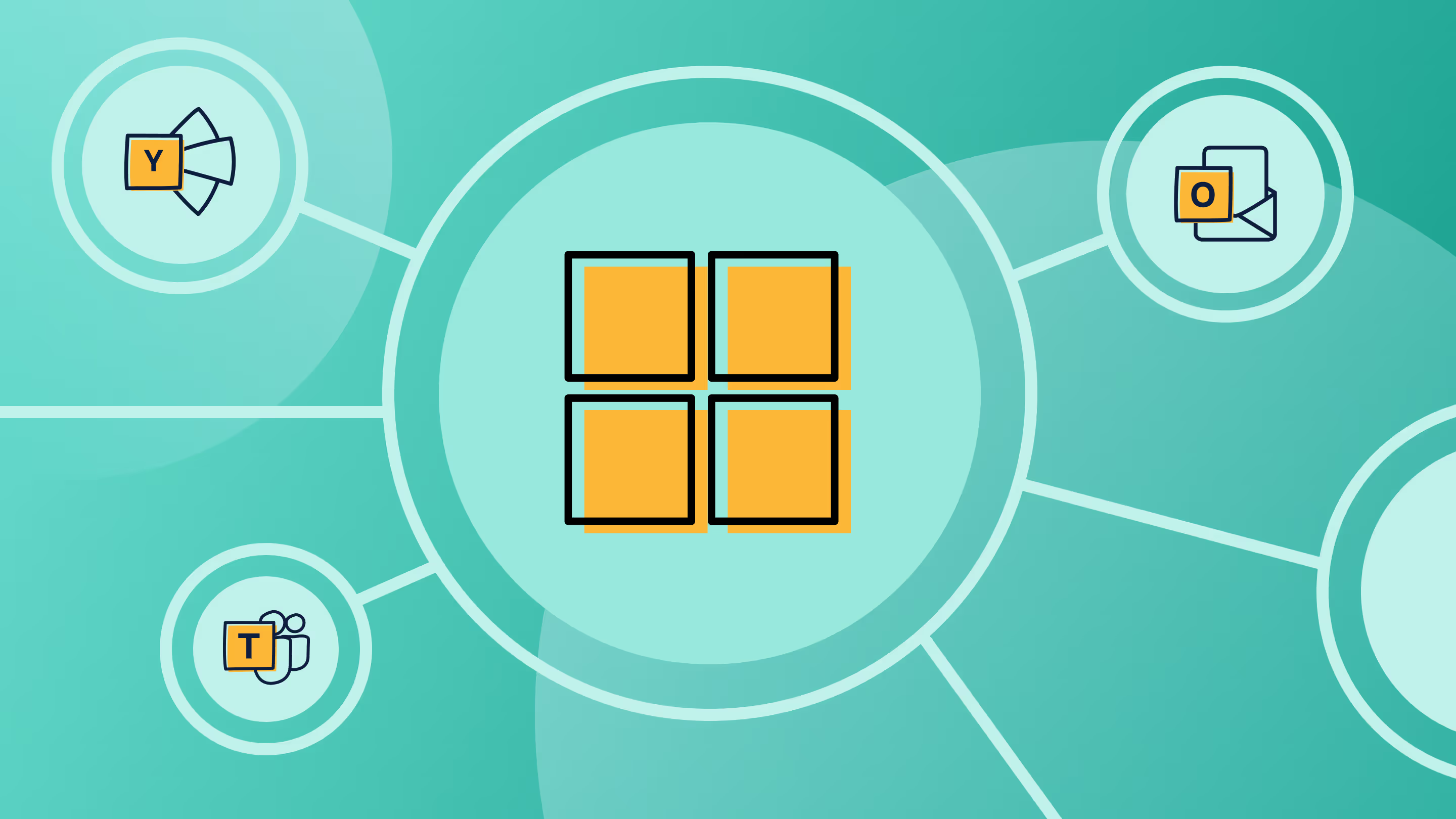
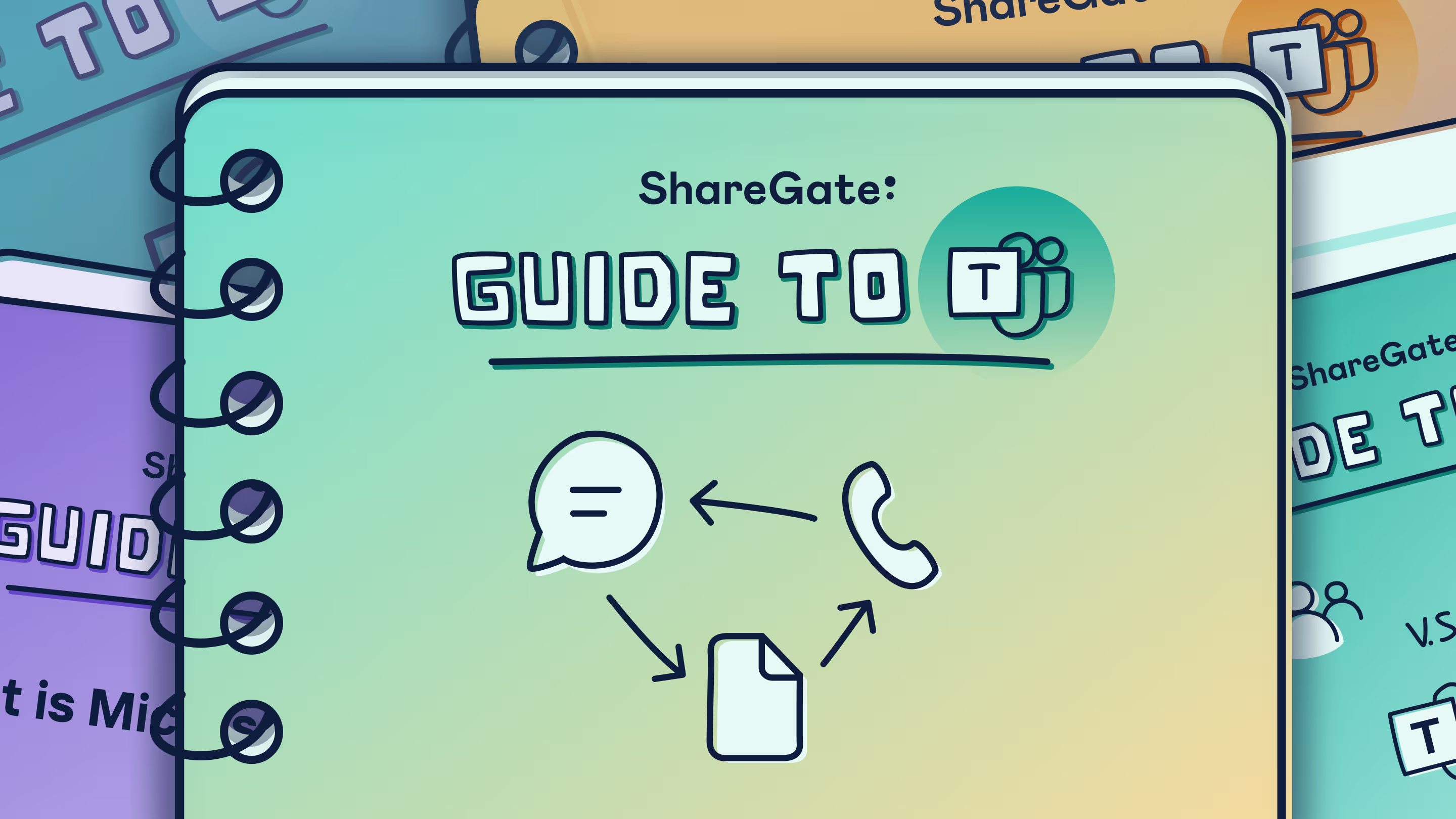



.jpg)


.png)

